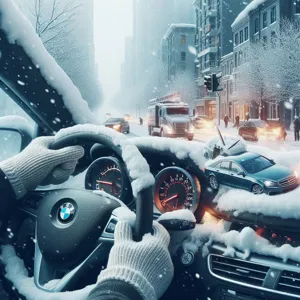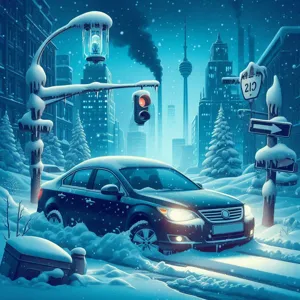As winter blankets the landscape in a shimmering layer of snow and ice, the beauty of the season is often accompanied by the challenges of driving in harsh conditions.
Navigating slick roads and reduced visibility can turn even the simplest trip into a test of skill and caution. With winter weather posing significant risks, it’s crucial to equip yourself with the knowledge and strategies necessary for safe driving during these chilly months. In this comprehensive guide, we’ll explore essential tips for mastering winter driving, from understanding your vehicle’s winter capabilities to implementing best practices for maintaining control on icy roads. Whether you’re commuting to work, heading out for holiday festivities, or embarking on a weekend getaway, these insights will empower you to tackle winter driving challenges with confidence and keep yourself and others safe on the road.
1. Understanding Winter Driving Hazards

Winter driving brings a unique set of challenges that can catch even the most experienced drivers off guard. Understanding these hazards is the first step toward mastering safe driving in icy and snowy conditions.
As temperatures drop and precipitation falls, roads can quickly transform into treacherous surfaces. Black ice, often invisible to the naked eye, forms when moisture freezes, creating a slick layer that can lead to dangerous skids. This invisible hazard is particularly common in shaded areas and bridges, where the temperature can be significantly lower than surrounding surfaces.
Snow accumulation presents another challenge, as it can obscure lane markings and create uneven road conditions. Driving on packed snow can be manageable, but as it turns to slush and melts, the risk of hydroplaning increases. Understanding the varying states of snow and ice will help you adapt your driving techniques accordingly.
Visibility is also significantly compromised during winter months. Snow flurries, sleet, and heavy rain can reduce your ability to see other vehicles and road signs, making it essential to keep your windshield wipers in good condition and your headlights clear. Additionally, the shorter daylight hours in winter mean that many drivers will be navigating in low-light conditions, further emphasizing the need for vigilance.
Finally, it’s important to recognize the impact of cold weather on your vehicle. Battery performance can diminish, tires can lose pressure, and fluids can thicken, all of which can affect your vehicle’s performance on the road. Regular vehicle maintenance is crucial to ensure that your car is equipped to handle winter’s demands.
By understanding these winter driving hazards, you empower yourself to make informed decisions behind the wheel. Awareness of the challenges ahead will not only enhance your driving skills but also promote safer roads for everyone during the winter months.
2. Preparing Your Vehicle for Winter Conditions
Preparing your vehicle for winter conditions is a critical step in ensuring your safety on the road. As temperatures drop and snow begins to fall, taking the time to equip your vehicle for the challenges ahead can make all the difference. Start by checking your tires; they are your only contact with the road, so consider investing in winter tires that provide better traction in icy and snowy conditions. Look for tires with deeper treads and a rubber compound designed to remain flexible in cold weather.
Next, ensure your battery is up to the task. Cold weather can significantly reduce battery performance, so have it tested to confirm it’s in good condition. If your battery is more than three years old, it might be wise to replace it proactively. Don’t forget to inspect your windshield wipers and replace them if they show signs of wear. Clear visibility is crucial, and using winter wiper blades can help tackle those heavy snowfalls.
Additionally, check your fluids. Make sure your antifreeze is at the correct level to prevent your engine from freezing and ensure your windshield washer fluid is rated for low temperatures to keep your view clear. If you live in an area prone to severe winter weather, consider keeping an emergency kit in your vehicle. This kit should include items like a blanket, flashlight, first aid supplies, non-perishable snacks, and a shovel.
Finally, don’t overlook the importance of having a full gas tank. Keeping your tank at least half full can prevent your fuel lines from freezing and provides you with extra weight for better traction. By taking these proactive steps to prepare your vehicle, you can navigate winter roads with confidence and peace of mind, ready to face whatever the season throws your way.
3. Essential Winter Tires: Why They Matter

When winter descends, transforming roads into icy lanes and snow-laden paths, the importance of equipping your vehicle with the right tires cannot be overstated. Essential winter tires are specifically designed to tackle the unique challenges that cold-weather driving presents. With deeper treads and specialized rubber compounds, these tires provide superior traction on slippery surfaces, significantly enhancing your vehicle’s grip and responsiveness.
Unlike all-season tires, which can stiffen and lose flexibility in frigid temperatures, winter tires remain pliable, allowing for better contact with the road. Their unique tread patterns are engineered to channel slush, snow, and water away from the tire surface, helping to prevent hydroplaning and improving stability. This means that whether you’re navigating through a thick snowstorm or maneuvering on icy patches, winter tires are your best defense against skidding and loss of control.
Moreover, many drivers underestimate the impact that proper winter tires can have on braking distances. Studies show that vehicles equipped with winter tires can stop up to 30% shorter than those with all-season ones on snow and ice. This could mean the difference between maintaining control and a potential accident.
Investing in a quality set of winter tires not only enhances your safety but also boosts your confidence behind the wheel during the harsh winter months. As you prepare for the winter driving season, consider making the switch to these essential tires. Your vehicle—and your peace of mind—will thank you.
4. Checking Your Vehicle’s Fluids and Battery
Before hitting the winter roads, one of the most crucial steps in ensuring your vehicle’s performance is to check its fluids and battery. Cold temperatures can significantly affect your car’s essential systems, making it imperative to pay extra attention to these components.
Start with your engine oil; in colder months, you may need to switch to a lighter oil that flows more easily in frigid temperatures. This small adjustment can enhance your engine’s efficiency and ensure smooth starts, even on the frostiest mornings. Next, inspect your coolant levels. A proper mix of antifreeze and water is vital to prevent freezing and overheating during extreme weather fluctuations.
Don’t forget about your windshield washer fluid, either. In winter, you should opt for a fluid specifically designed to withstand low temperatures and effectively combat road grime and salt. This will help maintain clear visibility, a crucial factor for safe driving in snowy or icy conditions.
The battery is another essential component to check thoroughly. Cold weather can reduce battery efficiency, leading to potential starting issues. Inspect the battery terminals for corrosion and ensure they’re clean and tight. If your battery is more than three years old, consider having it tested at a local shop to determine its capacity to hold a charge.
Additionally, check all other fluids, including brake fluid, power steering fluid, and transmission fluid. A well-maintained vehicle will not only perform better in winter conditions but will also provide you with peace of mind during your travels. By taking these proactive measures, you can navigate the icy roads with confidence, knowing your vehicle is in optimal condition.
5. Creating a Winter Emergency Kit

A well-prepared winter emergency kit can be a lifesaver when unexpected challenges arise on the road. As winter storms can bring treacherous conditions and even cause accidents, having the right supplies on hand can make all the difference in staying safe until help arrives. Start by choosing a sturdy, waterproof container to house your kit, ensuring that it remains protected from the elements.
Begin with the essentials: a first aid kit stocked with band-aids, antiseptic wipes, and necessary medications. Next, include warm blankets and extra clothing, such as hats, gloves, and scarves, to shield against the biting cold. A flashlight with extra batteries is crucial for illuminating dark surroundings, while non-perishable snacks and bottled water will sustain you if you find yourself stranded for an extended period.
Don’t forget practical tools and supplies: a snow shovel for clearing the way, a ice scraper for removing frost from your windows, and a set of jumper cables to help restart a dead battery. Additionally, keep a bag of sand or kitty litter handy for added traction on slippery surfaces. A whistle can also be an invaluable tool for signaling for help if needed.
Finally, to be fully prepared, make sure to include a fully charged portable phone charger to maintain communication with loved ones or roadside assistance services. Regularly check and update your kit as needed, especially as winter progresses or if you use any of the items. By creating a comprehensive winter emergency kit, you’ll not only ease your mind but also enhance your readiness for whatever winter throws your way.
6. Tips for Maintaining Visibility in Snow and Ice
Driving in winter conditions can be treacherous, and one of the key factors in staying safe is maintaining visibility in snow and ice. When the flurries start to fall, it’s crucial to ensure that your view of the road ahead is as clear as possible. Here are some essential tips to help you keep your visibility sharp during those wintry drives.
First and foremost, always ensure your windshield wipers are in good working condition. The last thing you want is to be caught in a snowstorm with worn-out blades that smear snow and ice across your view. Invest in a quality set of winter wiper blades designed to handle the harsh conditions. Additionally, keep your windshield washer fluid topped off with a solution that’s rated for freezing temperatures—this will help you clear away any accumulated slush quickly.
Next, don’t neglect your headlights and taillights. In snowy conditions, visibility can drop significantly, so it’s important to ensure all your lights are functioning and clean. Ice and grime can accumulate quickly, blocking light output and making it harder for other drivers to see you. A quick wipe down before you hit the road can make a significant difference.
Utilize your defrosters and heaters strategically. Snow and ice can cause your windows to fog up from the inside, reducing visibility. Turn on your car’s defroster to keep the glass clear, and if necessary, crack a window to help equalize the temperature inside and out. This small adjustment can prevent the dreaded fog from obscuring your view.
Lastly, adjust your driving habits for the conditions. Reducing speed is crucial in snowy or icy weather, as it gives you more time to react if visibility worsens or if you encounter slippery patches. Keep a safe distance from the vehicle in front of you, as braking distances increase in winter conditions.
By taking these proactive steps, you can maintain clear visibility in snow and ice, making your winter driving experience safer and more manageable. Remember, the key to mastering challenging conditions is preparation—and that starts with ensuring you can see the road ahead.
7. Adjusting Your Driving Techniques for Winter Conditions

When winter weather strikes, the road can transform from a familiar route to a treacherous journey in the blink of an eye. Adjusting your driving techniques for winter conditions is not just a precaution—it’s a necessity for ensuring your safety and the safety of others on the road. The key is to adapt your driving style to the challenges posed by snow, ice, and reduced visibility.
First and foremost, slowing down is essential. Reduced speeds give you more time to react to unexpected obstacles and changes in road conditions. Remember, even if the speed limit is 60 mph, that doesn’t mean it’s safe to drive at that speed when winter weather is present. In fact, you should aim to drive significantly below the speed limit when conditions are poor.
Next, focus on increasing your following distance. In dry conditions, a safe distance may be three seconds behind the car in front of you, but in winter weather, this gap should be extended to at least six seconds. This extra space provides ample room to stop in case the vehicle ahead suddenly brakes or skids.
Turning and braking require a gentle touch during winter driving. Sudden movements can lead to loss of traction and control, so make all turns slowly and deliberately. When braking, use a light foot and consider pump-braking in slippery conditions instead of slamming on your brakes, which can cause your wheels to lock and your vehicle to skid.
Moreover, ensure your headlights are on, even during the day. This simple adjustment significantly enhances your visibility to other drivers and helps you see the road ahead more clearly in low-light conditions, such as during snowstorms or heavy overcast skies.
Lastly, keep an eye on weather forecasts and road conditions before you set out. If conditions are particularly severe, don’t hesitate to postpone your trip. Your safety is far more important than arriving on time.
By implementing these driving techniques, you’ll be better equipped to handle the unique challenges of winter roads, ensuring a safer journey for yourself and fellow travelers.
8. Understanding Black Ice: How to Recognize and React
Understanding black ice is crucial for winter driving safety, as it can be one of the most deceptive and dangerous conditions you’ll encounter on the road. Unlike regular ice, which appears frosty and can be seen on the surface, black ice is often nearly invisible, blending seamlessly with the asphalt. It typically forms when temperatures hover around freezing, especially during the night when moisture in the air condenses and freezes on the road. Early morning drives or late-night excursions are particularly risky, as the road may look wet but can actually be coated with a thin layer of this treacherous ice.
To recognize black ice, be vigilant for subtle signs. Look for areas where the road appears darker than its surroundings—this is often an indication of a slick layer of ice. Bridges and overpasses are notorious spots for black ice; they cool down faster than other road surfaces, so be especially cautious when driving over these structures. If you notice other drivers swerving or braking suddenly, take that as a warning sign to decrease your speed and stay alert.
Reacting appropriately to black ice can mean the difference between a safe drive and a dangerous situation. The golden rule is to stay calm. If you find yourself on black ice, avoid sudden movements; do not slam on the brakes or jerk the steering wheel. Instead, gently lift your foot off the accelerator and steer into the direction of the slide. This technique helps regain control of your vehicle. If you do start to skid, remember to steer in the same direction you want the front of the car to go, and remain steady on the wheel.
Preparing for winter driving also means equipping your vehicle with proper tires and having emergency supplies on hand. With awareness and careful reactions, you can navigate black ice and other challenging winter conditions, ensuring your safety and that of others on the road.
9. The Importance of Maintaining Safe Following Distances
Maintaining safe following distances is crucial when it comes to winter driving, where road conditions can be unpredictable and treacherous. As snow and ice accumulate on the pavement, your vehicle’s stopping distance can increase significantly—sometimes by as much as four to ten times compared to dry conditions. This means that what might feel like a comfortable buffer during milder weather can quickly turn into a dangerous situation when the roads are slick and slippery.
To ensure you maintain a safe distance, start by following the “three-second rule” as a baseline. On dry roads, this guideline suggests that you should stay at least three seconds behind the vehicle in front of you. However, during winter, especially when conditions are poor, it’s wise to extend that distance to at least six or even eight seconds. This extra time allows for reaction in case the vehicle ahead suddenly brakes, or if you encounter unexpected obstacles like patches of ice or snowdrifts.
To gauge your following distance, pick a fixed point along the road, such as a sign or a tree. When the vehicle ahead of you passes that point, start counting seconds. If you reach the point before you’ve counted to your designated number, you should increase your distance.
Remember, visibility is often reduced during winter storms; snow can fall heavily, and fog can roll in unexpectedly, making it even harder to react in time. By keeping a safe following distance, you not only give yourself the space needed to brake safely but also project a sense of caution and responsibility to other drivers. This simple yet effective strategy can be a game-changer, significantly reducing the likelihood of accidents and ensuring a safer journey for you and your passengers.
10. How to Handle Skids and Loss of Control
When winter storms paint the roads with a treacherous layer of ice and snow, knowing how to handle skids and a loss of control can make the difference between a close call and a serious accident. As you navigate through these challenging conditions, it’s essential to remain calm and confident, allowing your instincts to guide you in the right direction.
First and foremost, if you find yourself skidding, resist the urge to slam on the brakes; this can exacerbate the situation. Instead, gently ease off the accelerator and steer in the direction you want the front of your car to go. This technique—known as “steering into the skid”—allows your tires to regain traction and helps realign your vehicle with the road.
Understanding the dynamics of your vehicle is equally important. Rear-wheel drive cars, for example, are more prone to skids, so if you’re behind the wheel of one, be particularly aware of how it responds to slippery surfaces. Front-wheel drive vehicles tend to offer better control, but they too can lose traction. Familiarize yourself with your vehicle’s handling in different conditions, ideally in a safe, controlled environment.
Anticipating potential skidding scenarios also plays a crucial role in winter driving. Keep a safe distance from the car in front of you, allowing ample space to react if they suddenly brake. Slow, gradual turns are key—sharp movements can lead to loss of control, so take it easy on the steering wheel.
Lastly, equip your vehicle with the right winter tires. These tires are designed to offer better grip on icy and snowy roads, significantly reducing your chances of skidding. Pair this with proper tire pressure checks, as cold temperatures can deflate tires, further compromising your control.
By mastering these techniques and staying composed, you can navigate the icy roads with confidence, ensuring both your safety and the safety of those around you. Remember, preparation and awareness are your best allies in conquering winter driving challenges.
11. Navigating Hills and Slopes Safely
Navigating hills and slopes during winter can be one of the most daunting challenges for drivers, especially when snow and ice blanket the road. Mastering this skill is crucial for ensuring your safety and that of others on the road. Here are some essential tips to help you tackle these tricky terrains with confidence.
First and foremost, approach hills with caution. As you near an incline, assess the road ahead. If you see other vehicles struggling or sliding, it’s wise to slow down and consider an alternate route. When you do decide to ascend, maintain a steady speed without accelerating rapidly. Sudden bursts of power can lead to wheel spin, which is especially dangerous on icy surfaces. Instead, use a gear that allows for a consistent speed—this will provide better traction and help you climb smoothly.
As you ascend, keep your eyes on the summit. If you see a steep drop or a sharp turn at the top, prepare to reduce your speed before reaching the crest. Remember, what goes up must come down. When descending, shift into a lower gear to help control your speed, rather than relying solely on your brakes. This technique helps prevent your brakes from overheating and losing effectiveness, especially on slick surfaces.
Always avoid sudden maneuvers, whether you’re going up or down a hill. Quick turns or lane changes can lead to loss of control, particularly if your tires are biting into ice or packed snow. If you begin to slide, remain calm and steer gently in the direction you want to go. Sudden corrections can lead to oversteering, which may worsen the situation.
Lastly, don’t forget to keep your vehicle well-maintained for winter conditions. Ensure your tires are suitable for snow and ice, with adequate tread depth. Keep your windshield wipers in good condition and your fluid reservoirs filled with winter-grade products to ensure maximum visibility.
By practicing these strategies and remaining attentive, you can navigate hills and slopes safely during the winter months, turning a potentially perilous journey into a manageable one. Your confidence and preparedness will not only keep you safe but also contribute to a more secure road environment for everyone.
12. Dealing with Other Drivers: Staying Safe on the Road
When winter weather strikes, the roads become a shared challenge that tests the skills and patience of every driver. Dealing with other drivers in these conditions requires heightened awareness and a strategic approach to safety. First and foremost, it’s essential to maintain a safe following distance. This buffer zone gives both you and the drivers around you enough time to react to sudden stops or skidding that can occur on icy roads.
Anticipate the actions of others; not every driver will adapt their habits to the winter conditions. Some may still accelerate too quickly or brake too hard, leading to potential accidents. Be cautious when approaching intersections, where black ice can form unnoticed, and always be prepared for the unexpected—like a driver who misjudges their stopping distance and comes to a halt much closer than you’d expect.
Consider using your lights to increase visibility, particularly during heavy snowfall or low-light conditions. This simple action can make a significant difference, helping you stand out in a sea of white. Additionally, signaling your intentions well in advance can help prevent misunderstandings with drivers who may be more focused on their own challenges than on the road ahead.
It’s also wise to remain calm and composed. Winter driving can provoke frustration, especially when encountering reckless behavior from other motorists. However, reacting with aggression can escalate situations unnecessarily. Instead, focus on defensive driving techniques: stay alert, obey speed limits, and be ready to yield to others if they make erratic moves.
Lastly, if conditions become too treacherous, don’t hesitate to make the responsible decision to pull over to a safe location until the weather improves. Remember, ensuring your safety and the safety of others on the road should always be your top priority during winter driving. By staying aware and practicing patience, you can navigate the challenges of winter roads more effectively, helping to keep yourself and those around you safe.
13. Planning Your Routes: Avoiding Dangerous Areas
When winter weather strikes, planning your routes becomes an essential skill for safe driving. This isn’t just about knowing the fastest way to your destination; it’s about being strategic in avoiding potentially treacherous conditions. Before you even turn the key in your ignition, take a moment to review weather forecasts and road conditions. Many local news stations and websites provide real-time updates on road closures, black ice, or heavy snowfall in certain areas, allowing you to adjust your route accordingly.
Utilize mapping apps that offer live traffic updates, as they can alert you to hazardous conditions or accidents along your planned path. These tools can help you identify safer alternatives, whether that means opting for a well-maintained highway instead of a winding back road or choosing a route that avoids known trouble spots like steep hills or poorly plowed neighborhoods.
Additionally, consider the time of day you’ll be driving. Daylight can be your ally, allowing you to navigate more safely and spot potential hazards like icy patches or snowdrifts. If you must travel after dark, be extra vigilant in your route planning; familiarize yourself with the roads you’ll be taking and identify places where you can safely pull over if conditions worsen.
Lastly, don’t hesitate to reach out to locals or consult community forums for tips on which routes are best during winter months. This collective knowledge can be invaluable, helping you avoid areas known for their winter driving challenges. By taking the time to plan your routes carefully, you’re not only safeguarding your journey but also ensuring peace of mind as you navigate the often unpredictable winter landscape. Remember, a little foresight can go a long way in keeping you safe on the roads this winter.
14. When to Avoid Driving Altogether
Driving during winter can present a myriad of challenges, and while preparation can greatly enhance your safety on the road, there are times when the best decision is to simply avoid driving altogether. Recognizing these instances can protect not only you but also other road users.
First and foremost, if severe weather warnings are issued, heed them. Heavy snowfall, ice storms, or blizzard conditions can render roads treacherous, making even seasoned drivers feel vulnerable. If local authorities advise against travel, take that advice seriously. Check weather apps or local news stations for real-time updates on conditions, and remember that forecasts can change rapidly.
Additionally, if you find yourself in a situation where visibility is severely compromised—whether due to heavy snow, fog, or a combination of both—consider postponing your trip. When you can’t see clearly, it becomes nearly impossible to react appropriately to other vehicles, pedestrians, or changing road conditions.
Another critical factor is your personal comfort level with driving in adverse conditions. If you’re not confident in your ability to manage your vehicle on slippery roads or if you feel fatigued, it’s wise to stay off the roads. Fatigue can impair your reaction time and decision-making, increasing the risk of an accident.
Lastly, consider the time of day. Nighttime driving during winter can be particularly hazardous due to lower visibility and the likelihood of icy patches forming. If you can plan your travel during daylight hours, you’ll enhance your ability to navigate safely.
In summary, recognizing when to avoid driving altogether can be as crucial as any driving skill you possess. Prioritize safety by assessing weather conditions, your own comfort level, and the time of day—sometimes the safest choice is to stay home and wait for conditions to improve.
15. Conclusion: Staying Safe and Confident on Winter Roads
As we wrap up our exploration of essential tips for safe winter driving, it’s important to remember that confidence on the road stems from preparation, knowledge, and awareness. Winter weather can be unpredictable, transforming familiar routes into treacherous paths. However, by embracing the strategies outlined in this guide, you can navigate these challenges with greater ease and assurance.
Start by ensuring your vehicle is winter-ready—this means having the right tires, a well-functioning battery, and essential fluids that can withstand freezing temperatures. Equip your car with a winter emergency kit that includes items like blankets, a flashlight, food, and a first-aid kit. This preparedness can make all the difference should you encounter unexpected situations.
Furthermore, adopting safe driving practices—such as maintaining a safe following distance, reducing speed, and avoiding sudden maneuvers—will enhance your control over the vehicle. Remember, it’s not just about reaching your destination; it’s about getting there safely.
Lastly, keep an eye on weather forecasts and road conditions before heading out. If the weather looks particularly brutal, don’t hesitate to adjust your plans. Staying informed will help you make better decisions and allow you to avoid dangerous situations altogether.
With these tips in hand, you can approach winter driving with a sense of confidence and safety. Each journey taken with caution not only protects you but also ensures that you arrive at your destination ready to tackle whatever life has in store, regardless of the weather. Embrace the winter season, drive safely, and enjoy the beauty that comes with it!
As we wrap up our exploration of essential tips for safe winter driving, we hope you feel empowered to tackle the challenging conditions that come with the season. From mastering the art of handling icy roads to understanding the importance of maintaining your vehicle, each step plays a crucial role in keeping you safe on the road. Remember, preparation and awareness are your best allies when winter weather strikes. By applying the strategies outlined in this post, you can confidently navigate through snow and ice, ensuring not just your safety but also that of your passengers and fellow drivers. So bundle up, drive carefully, and embrace the beauty of winter—just with a little extra caution! Safe travels, and may your journeys be clear and uneventful this winter season.






